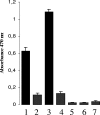New adhesin of enteroaggregative Escherichia coli related to the Afa/Dr/AAF family
- PMID: 18443096
- PMCID: PMC2446688
- DOI: 10.1128/IAI.01646-07
New adhesin of enteroaggregative Escherichia coli related to the Afa/Dr/AAF family
Abstract
Enteroaggregative Escherichia coli (EAEC) is an important cause of diarrhea worldwide. We analyzed 17 Danish EAEC strains, isolated in the course of a case control study, for phenotypic and genotypic properties. The strains belonged to at least 14 different serotypes. Using PCR to investigate the prevalence of various putative virulence genes, we found that all but two strains were typical EAEC, as they harbored all or part of the previously described AggR regulon. The majority of the strains harbored genes encoding aggregative adherence fimbriae (AAF). The most common was AAF/I, found in nine strains; eight strains carried no known AAF-related genes. We utilized TnphoA mutagenesis to localize the aggregative adherence (AA) adhesin from one typical EAEC strain, C1010-00, which lacked a known AAF. We identified a TnphoA insertion in a hypothetical Dr-related pilin deposited in GenBank as HdaA. Four additional Danish strains harbored HdaA, and all but one displayed AA to HEp-2 cells. By using PCR primers derived from the pilins and ushers from the three AAF and Hda, we found that 16 of 17 strains exhibited evidence of one of these factors; importantly, the one negative strain also lacked the aggR gene. Cloning of the complete Hda gene cluster and expression in E. coli DH5alpha resulted in AA and complementation of the C1010-00 nonadherent mutant. Four related adhesins have now been found to confer AA in typical EAEC strains; our data suggest that, together, these variants may account for AA in the large majority of strains.
Figures





References
-
- Adachi, J. A., C. D. Ericsson, Z. D. Jiang, M. W. DuPont, S. R. Pallegar, and H. L. DuPont. 2002. Natural history of enteroaggregative and enterotoxigenic Escherichia coli infection among US travelers to Guadalajara, Mexico. J. Infect. Dis. 1851681-1683. - PubMed
-
- Adachi, J. A., Z. D. Jiang, J. J. Mathewson, M. P. Verenkar, S. Thompson, F. Martinez-Sandoval, R. Steffen, C. D. Ericsson, and H. L. DuPont. 2001. Enteroaggregative Escherichia coli as a major etiologic agent in traveler's diarrhea in 3 regions of the world. Clin. Infect. Dis. 321706-1709. - PubMed
-
- Baudry, B., S. J. Savarino, P. Vial, J. B. Kaper, and M. M. Levine. 1990. A sensitive and specific DNA probe to identify enteroaggregative Escherichia coli, a recently discovered diarrheal pathogen. J. Infect. Dis. 1611249-1251. - PubMed
Publication types
MeSH terms
Substances
Associated data
- Actions
- Actions
Grants and funding
LinkOut - more resources
Full Text Sources

